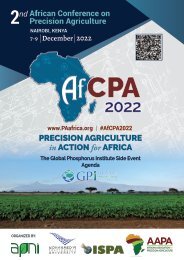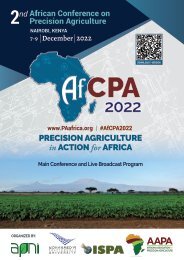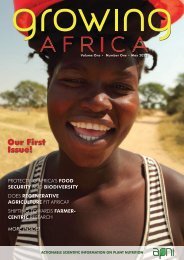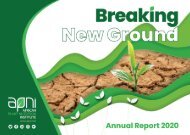APNI Annual Report 2022 - Towards Transformation
You also want an ePaper? Increase the reach of your titles
YUMPU automatically turns print PDFs into web optimized ePapers that Google loves.
45<br />
drought tolerant crop. There<br />
40<br />
PRECISION NUTRIENT MANAGEMENT<br />
is a need to increase awareness<br />
FORUM<br />
2017 2018 2019<br />
SUB-SAHARAN AFRICA<br />
35<br />
among farmers that like any<br />
other crop, sorghum requires<br />
30<br />
where rapid transformation is seen<br />
<strong>Towards</strong> a Farmer-Centric<br />
Share your more Snapshots<br />
attention to soil fertility<br />
to arise 25 from multiple coinciding<br />
UP SCALING<br />
influences, events, trends or even<br />
management.<br />
Framework for Scaling<br />
major cereal crops (Fig. 2).<br />
shocks 20 (Schut el al. 2020). In<br />
Share your photos A from decline the in field the on Instagram using the hashtag<br />
Policy<br />
These processes are farmerdriven<br />
and provide a platform<br />
complex adaptive research and makers<br />
#ShareGrowingAfrica predictability of rainfall<br />
15<br />
Productive and Sustainable development systems, continuous<br />
for international Not Instagram research results yet? You in inability can submit to your plan<br />
monitoring<br />
photos to communications@apni.net<br />
10 and learning through<br />
organizations for a chance and national<br />
Cereal Cropping Systems<br />
to be featured in our next issue.<br />
feedback loops, system/sub-system RAPID & CONTINUOUS<br />
for specific farm operations<br />
FEEDBACK<br />
research and extension<br />
5<br />
By Ivan S. Adolwa, Thomas Oberthür and Simon Cook<br />
interrelationships NARES/ and context,<br />
Farmer<br />
systems (NARES) due to to work uncertainty. Future<br />
OUT SCALING<br />
Academia<br />
organizations<br />
reflexive thinking, trade-offs<br />
OUT SCALING<br />
0<br />
On-farm<br />
effectively with consideration farmers. is needed to<br />
and uncertainty, Maize and Sorghum adaptive experimentation<br />
Groundnut Cotton CO-LEARNING Pigeon pea Bean Millet Others<br />
A case is made for an innovation system framework that<br />
A tripartite of develop the capacity among<br />
management are MONITORING key (Cook et & al. Knowledge<br />
integrates farmer-centric and systemic approaches to scaling<br />
Figure 3. Proportion & of crops exchange grown within the study area during the 2017-2019<br />
farmer organizations,<br />
2018; Klerkx et professionals to predict future<br />
EVALUATION al. 2012).<br />
plant nutrition innovations for positive transformation of cereal<br />
farming seasons.<br />
international research<br />
Industry/<br />
Therefore, the target of<br />
International<br />
rainfall patterns through<br />
cropping systems in Sub-Saharan Africa. A case study from<br />
Private<br />
MULTI-STAKEHOLDER research<br />
organizations, and NARES/<br />
sector<br />
increased cereal crop productivity ARRANGEMENTS<br />
Ethiopia helps to build the case.<br />
Academia constitute a sub-system modeling approaches. Modeled<br />
of the inclusion of grain legume This requires promotion and<br />
calls for an innovative framework<br />
of support within the larger scenarios could eventually<br />
that crops translates on the scientific P balance of this novel intensification of the AKIS. production For scaling processes to<br />
be used to develop extension<br />
knowledge cropping on system. PNM into<br />
of drought tolerant be crops successful, like it is crucial that<br />
ereal-based cropping right rate, time, and place) and<br />
messages for farmers that<br />
sorghum in order to enhance<br />
C<br />
Development<br />
innovations that can be adopted agencies<br />
systems are vital food best crop management practices<br />
by famers Summary at scale. African<br />
present most likely predictions<br />
production systems provides a plausible pathway<br />
Additional issues and<br />
regional food security. Farmers,<br />
farmers will obtain higher ROI by DOWN SCALING<br />
across Africa. In these systems, for sustainably increasing the<br />
Under a changing climate,<br />
considerations for plant and how they can prepare and<br />
adopting market-oriented models<br />
however, do not prioritize<br />
livelihoods are mainly derived productivity of African cereal crop<br />
nutrition innovation<br />
drought is becoming common<br />
plan their farm operations.<br />
are anchored on structured<br />
from cereals such as maize, yields from the current 2.5 t ha fertilizer use in sorghum. Where<br />
-1<br />
include:<br />
markets in Malawi, and credit as access. is food shortages<br />
In general, planting new<br />
millet, sorghum, and wheat; and to attainable yields of 5-7 t ha -1<br />
they have access to fertilizer,<br />
Knowledge for Malawian transfer households.<br />
and agribusiness<br />
could SMART potentially PLANT propel NUTRITION<br />
1 A socioeconomic crops and adopting droughtalso<br />
legumes, pulses, roots and (Phillips, 2014; van Ittersum et Figure 2. Scaling Framework for Cereal Cropping Systems. the priority crop is maize, characterization a less of the<br />
CLIMATE & WEATHER<br />
tubers. In East and Southern al., 2016). Continued stagnation<br />
farming systems to clarify<br />
MALAWI<br />
Africa, maize-mixed farming in productivity results from a<br />
sowing the move in rows) towards were cropping aimed at underlie such decision-making,<br />
factors that underpin<br />
systems are the most important<br />
being an inspiration for farmer many more studies across several farmer decision-making.<br />
food production systems<br />
groups to offer them alternatives agro-ecological sites and regions<br />
zones in Chikwawa, Salima, and<br />
2 A review of innovations<br />
with high scaling potential<br />
Exploring Climate Smart<br />
for crop production. It was need to be conducted to get a<br />
representing 32 million ha (19%)<br />
Blantyre districts over the last<br />
for different locations.<br />
Agricultural systems observed are increasingly that farmers matched being clearer picture.<br />
of the cultivated area (Dixon<br />
20-25 years. The majority of<br />
et<br />
Cropping<br />
al. 2001). These systems<br />
System<br />
are<br />
Solutions<br />
viewed in terms of their complex experimental<br />
opinions systems design<br />
tended to thinking, A framework for scaling 3 Mapping stakeholder<br />
express either<br />
Dr. Samuel networks Njoroge using tools such<br />
with the requirements of their processes underpinned by<br />
encumbered by food insecurity,<br />
as Social Network Analysis<br />
a substantial increase or decline<br />
Researchers on-site to inspect a set of nutrient omission plots (NOTs) for wheat growing in Minjar Shenkora District,<br />
for Smallholder “ Farmers where rapid transformation or scaling is seen<br />
(a) (b) (c)<br />
livelihood system. In this case, the agricultural knowledge<br />
to identify those partners<br />
hunger and poverty, but these<br />
in the Amhara region of Ethiopia. The plots evaluated the effect of omitting nitrogen, phosphorus, potassium, and<br />
to arise from multiple farmers<br />
for coinciding each<br />
focused<br />
indicator.<br />
on enhancing influences, In general,<br />
innovation systems (AKIS)<br />
best placed to fulfill scaling<br />
micronutrients on wheat growth and yield, against a plot receiving a balanced application of all nutrients.<br />
problems can be alleviated by<br />
By Austin T. Phiri, Sarah E. Edewor, Judith S. Kahamba, Ijeoma Nwoko,<br />
there is overwhelming evidence of<br />
functions.<br />
straw productivity (for fodder) approach, centered on OFE, is<br />
Greater shift<br />
successful and Ulemu yield Chimimba intensification and<br />
events, trends or even climate shocks.<br />
at the expense variance. of wheat Very grain few of the proposed for cereal cropping 4 Identifying key bottlenecks<br />
between seasons<br />
crop diversification (Garrity et al.<br />
to scaling and developing<br />
indicates higher<br />
respondents answered “remained<br />
temporal<br />
yields. A key outcome with systems. A key question hinges<br />
2012).<br />
scaling strategies and<br />
variability<br />
The effects of climate change are threatening the stability important the same” implications to the ten on components the on of whether and how OFE can<br />
approaches (e.g., Scaling<br />
Ultimately, a vision of success major failure current research<br />
of smallholder farmers in Malawi. As such, most farmers are trade-off system climate commercialization between variation fertilizer measured. cost and When contribute to scaling processes in Scan; Jacobs et al. 2018,<br />
for cereal cropping systems in and scaling processes, which<br />
Scaling Readiness; Sartas<br />
receptive to adaptive strategies such as increased adoption of and cereal yield asked yield increase, whether gap closure was climate that (Green change African farming systems.<br />
RYPK RYNK RYNP<br />
Africa includes the improvement embark on agricultural technology<br />
et al. 2020) to overcome<br />
drought-tolerant crops like sorghum. Here smallholders provide<br />
farmer-led et al., has 2016; had processes a Sanchez, direct did effect 2015). not of their<br />
of smallholder farmer livelihoods transfer with little regard for<br />
such bottlenecks.<br />
lead<br />
insight into the long-term impacts of climate change, and related household, to Precision significantly nutrient the majority different (91%) of An innovation system<br />
through better value creation the unique socio-organizational<br />
5 Monitoring Find us @africanplantinst and learning and share your best photos with us<br />
average respondents indicated “yes”.<br />
using the hashtag #ShareGrowingAfrica<br />
field research examines nutrient management within a new grain<br />
management wheat is grain critical yields (2,020<br />
and return on investment (ROI) conditions of target areas<br />
framework for cereal<br />
to track impact of scaling<br />
kg tackling ha<br />
legume-sorghum cropping system offering food security and<br />
-1 ) from<br />
A the the<br />
majority spatial scientific-led<br />
(69%) and<br />
approaches (e.g., impact<br />
Greater<br />
(Fig. 1). Precision nutrient (Adolwa et al. 2017; Schut et al.<br />
of cropping systems<br />
process temporal (2,200<br />
climate resilience.<br />
respondents variability kg ha<br />
across -1 ). in Although<br />
evaluation studies),<br />
African<br />
within spread<br />
indicates a season<br />
higher<br />
management (PNM) combined 2020). Agricultural systems are<br />
the three This model is centered<br />
and documentation<br />
Issue 2, <strong>2022</strong> | Growing Africa 37<br />
spatial variability<br />
this smallholder work contributes<br />
districts believe<br />
farming to<br />
average<br />
systems our<br />
with the 4R Nutrient Stewardship increasingly being viewed in terms<br />
daily around farmer-centric processes frameworks for measuring<br />
LR 2013<br />
understanding given its incorporation of the choices of<br />
and reporting of successes,<br />
(i.e., right nutrient source at the of complex systems thinking, temperatures have increased for experimentation (or OFE)<br />
SR2013<br />
farmers make in technology<br />
failures, or processes.<br />
LR2014<br />
substantially. Similarly, 58% and knowledge exchange on<br />
limate change awareness where its productivity is very low. adoption and of the processes that<br />
SR2014<br />
experienced Issue 1, <strong>2022</strong> a | Growing substantial Africa 23 plant nutrition innovation in<br />
is steadily increasing The average yield in Malawi is<br />
LR2015<br />
increase in the duration of dry<br />
C(Venghaus et al., <strong>2022</strong>) about 600 kg ha -1 SR2015<br />
against a yield<br />
Issue 1, <strong>2022</strong> | Growing Africa 25<br />
seasons or prevalence of drought.<br />
and has become a major concern potential of up to 3.5-6 t ha -1 for<br />
0.0 0.5 1.0 1.5 2.0 0.0 0.5 1.0 1.5 2.0 0.0 0.5 1.0 1.5 2.0<br />
About 49% of respondents<br />
among most stakeholders. In improved varieties available in the<br />
Relative yield<br />
perceived a substantial decline<br />
Malawi, the effects of increased country (GAP, 2012). Improved Sorghum productivity improvement trial in the 2020/2021 farming season at Chitala agricultural Research Station, Salima<br />
in average rainfall. Furthermore,<br />
Figure 2. Cumulative frequency (%) of maize grain yield (t ha<br />
average global temperature varieties yield higher than local district, central Malawi.<br />
-1 ): (a) Relative yield response to N (RYPK); (b) Relative yield response<br />
FORUM<br />
75% of the respondents reported<br />
to P (RYNK); and (c) Relative yield response to K (RYNP), across different on-farm nutrient omission trials locations (n=24), over six<br />
that induce weather variability varieties like Thengalamanga,<br />
consecutive cropping seasons. LR and SR refer to short and long rainy seasons respectively.<br />
a reduction in the length of the<br />
over years manifest as frequent with documented grain SOIL yields HEALTH of 24 FOR Growing IMPROVED Africa LIVELIHOODS<br />
| Issue 2, <strong>2022</strong><br />
rainy season. A majority also<br />
droughts, floods, heat, cyclones up to 2 t ha -1 SUB-SAHARAN AFRICA<br />
(ICRISAT, 1995).<br />
seasons (Janssen et al., 1987; fields showed very strong response fertilizer applications required<br />
perceived an increase in soil<br />
and cold waves. Malawi’s Studies indicate that improved<br />
Ask An <strong>APNI</strong> Expert<br />
dryness during the dry season.<br />
Kifuko et al., 2007). However, to K, while a decline in mean to attain and sustain high yields,<br />
National Adaptations<br />
varieties like Pilira 1 are preferred a key role in fixing it. Although the<br />
Why Given the prevalence of rain-fed<br />
the large variability in RY<br />
Programmes the of Action Buzz (NAPA) on<br />
NK RYNP was observed over time. findings from this study indicate<br />
by farmers for their early maturity, idea of ‘broken’ food systems is often<br />
agriculture in Malawi, decreases<br />
Question: How can I observed develop between a farms in the The strong K deficiencies in a that farmers in such smallholder<br />
report on Disaster Management drought tolerance, white grain, repeated, what this means is unclear.<br />
Regenerative in rainfall and rainy season<br />
model for precision agriculture?<br />
for Malawi identifies Chikwawa,<br />
Agriculture?<br />
first season, with about half of limited number of sites could be settings will face yield losses of up<br />
and high grain yield (Nkolongo Many commentaries point to an<br />
duration significantly reduces<br />
fields showing no response to P, due to the presence of localized to 50% if they drastically reduce<br />
Submitted by Tolera Goshu, Addis Ababa, Ethiopia<br />
Nsanje, Balaka, Salima and et al., 2008). Given sustainable agricultural crisis: a collapse in soil<br />
By Ken E. Giller<br />
farm productivity and increases<br />
indicates strong spatial variation. K deficiency hotspots (Kihara fertilizer applications. Such yield<br />
Karonga districts as the most agronomic practices, sorghum health, the sixth mass extinction<br />
household food shortages.<br />
o answer this question,<br />
Differences in yield response to et al., 2016), and continuous reductions would substantially<br />
vulnerable districts to climate appears poised enhance of biodiversity, and the plateauing<br />
Regenerative Agriculture is taking the world by storm! Civil<br />
change effects (GoM, 2006). household food security among of crop yields. Across This all regions, begged the<br />
we need to first define<br />
P can be linked to differences in removal of harvest products impact crop productivity, food<br />
society, agribusiness, farmers, NGOs, multinationals—and<br />
In Malawi, sorghum is one of smallholder farmers and build question largest as group to why of Regenerative respondents T“precision agriculture”.<br />
the P fertility status of the soil, without application of K fertilizer security and farmer incomes.<br />
increasingly researchers—are aligning around this new paradigm.<br />
the major food crops for people resilience to climatic shocks and<br />
Agriculture (41%) indicated was gaining that so incidences much<br />
Precision agriculture (PA)<br />
reflecting differences in historical (Chianu and Mairura, 2012;<br />
But what is Regenerative Agriculture? What does it mean for the<br />
Findings from this study<br />
attention<br />
living in the semi-arid regions food shortages.<br />
of unusually and demanded high rainfall a deeper and<br />
according to the International<br />
field management (Vanlauwe Zörb et al., 2014). Further, K<br />
way we produce our food and for agricultural research in Africa?<br />
however provide potential<br />
analysis.<br />
of shire valley and lakeshore<br />
thunderstorms Here I provide has increased a synopsis<br />
Society of Precision Agriculture<br />
et al., 2006). Omitting P for deficiencies are expected to short-term nutrient management<br />
of the<br />
areas. Since the crop tolerates<br />
substantially. paper we wrote Frequency/intensity<br />
to try<br />
is “A management strategy that<br />
Climate change<br />
more than one season resulted become more pronounced at options that farmers can apply<br />
high<br />
first<br />
temperatures<br />
heard the term<br />
and<br />
and drought, awareness<br />
Twitter, and a large body of and of understand storms and the other buzz wind-related<br />
around<br />
takes account of temporal and<br />
in significant reductions in yield higher N and P application rates.<br />
Regenerative Agriculture in farmers were communicating on Regenerative<br />
sorghum can be a key adaptation<br />
hazards were Agriculture perceived (Giller to have<br />
spatial variability to improve<br />
to mitigate severe yield losses.<br />
Table 1 presents the extent of<br />
as indicated by the significantly Fertilizer recommendations<br />
I2019 at an advisory meeting this topic. Over the course of 2020 et al.,<br />
strategy for the country. The<br />
increased 2021), and substantially I specifically by ask 46% of<br />
sustainability of agricultural<br />
In low fertility soils, yield losses<br />
climate variation experienced by<br />
smaller mean RYNK values, and should therefore account for the<br />
of a major food company. As a large number of companies started the<br />
bulk of sorghum production is<br />
the question respondents. regarding Strong what this destructive<br />
production.” Notice that the<br />
can be reduced by applying<br />
67 randomly selected farmers from<br />
an increasing proportion of fields need to supply K in combination<br />
an agricultural researcher I was to make commitments to move means<br />
done under rain-fed production<br />
winds for (known Africa. In as doing Mphepoyankuntho)<br />
so I<br />
word “technology” does not<br />
reduced quantities of balanced<br />
the three targeted agro-ecological<br />
responsive to P. This indicates with N and P, particularly in K<br />
embarrassed that I was not better towards Regenerative Agriculture draw on papers from a special issue<br />
appear in the definition. Many<br />
NPK applications as such soils<br />
informed, so together with an in their supply chains, and many on ‘Biomimicry and Nature-based<br />
people assume that PA is going<br />
the need for regular application deficiency hotspots (Kihara et al., are expected to be deficient<br />
20 Growing Africa | Issue 2, <strong>2022</strong><br />
Crop performance can vary greatly across a landscape due to natural changes in<br />
assistant we ran a quick scan of international environmental NGOs Solutions’, which I edited together<br />
to involve technology – sensors,<br />
of P to sustain productivity. 2016).<br />
soil properties plus the influence of field management history.<br />
in N, P and K. In moderate to<br />
the topic. We found surprisingly such as Greenpeace and The Nature with Jim Sumberg (see Sumberg,<br />
satellites, computers, etc., but<br />
Strong spatial-temporal<br />
Given the prevailing fertilizer high fertility soils that have<br />
little information in the scientific Conservancy aligned with the <strong>2022</strong>).<br />
according to the definition, PA such as lack of uniformity in input and water patterns availability? in response Are to K were crisis that is limiting the ability had previous large applications<br />
As we dug into both the<br />
Percent<br />
Cumulative frequency (%)<br />
20 40 60 80 100<br />
Growing Africa seeks out actionable<br />
scientific information to help enable<br />
Agricultural Research for Development.<br />
This open access publication is aimed<br />
at strengthening the connections within<br />
the research community in Africa, and<br />
shining a light on its impactful solutions,<br />
programs, concepts, and activities.<br />
As a provider of practical information,<br />
Growing Africa serves a broad target<br />
audience of agricultural practitioners<br />
including agronomists, researchers, and<br />
extension workers as well as university<br />
students, supply and value chain<br />
stakeholders, and policy makers.<br />
53








